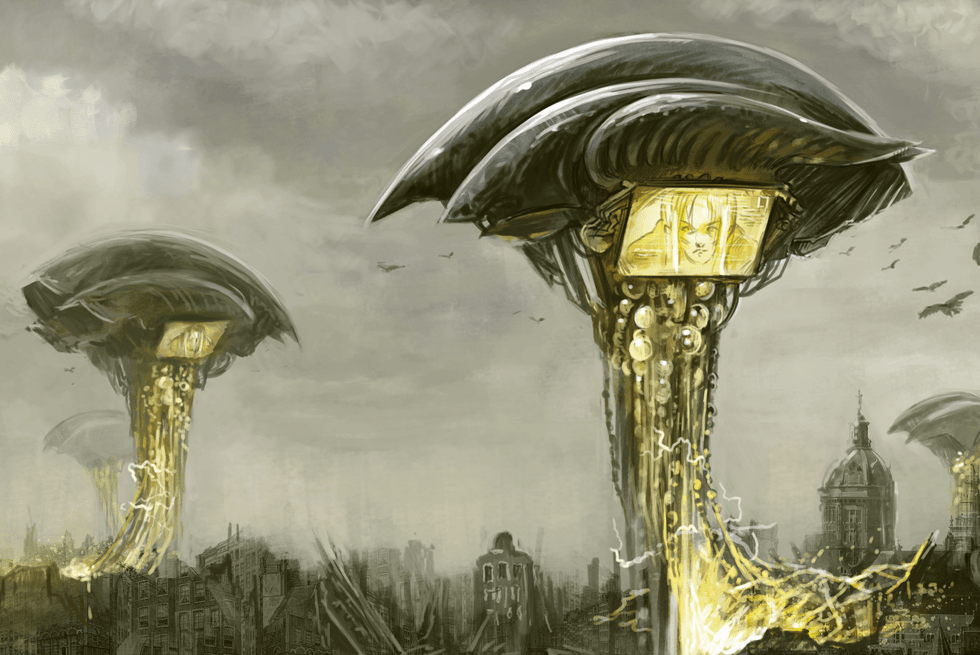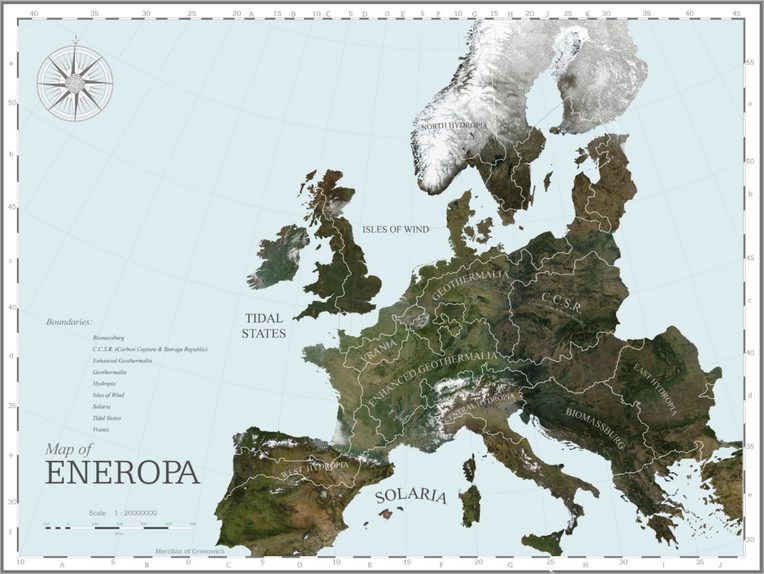Solarpunking Speculative Futures
From the Series: Speculative Anthropologies
From the Series: Speculative Anthropologies

Here is a map of Eneropa, a vision of the continent of Europe in 2050. Reorganized by renewable energy production, the new states—Hydropia, Solaria, Biomassburg, Geothermalia, Vrania, Tidal States, and the Isles of Wind—are connected by a centralized European energy grid. The grid serves to redistribute renewable energy across the continent by season, with the predominant energy supply from strong winterly winds in the north replaced by solar summers in the south. Europe’s carbon emissions have dropped by (at least) 80 percent from 1990s levels, and the continent is almost entirely energy-independent. The new, post-transition Europe is a safer, happier, and more politically stable place to live.

This is not an exercise in speculative fiction, but an example of backcasting: a policy technique of detailing a desirable future and then reverse-engineering solutions to achieve it. This map was featured in a 2010 vision document entitled “Roadmap 2050: A Practical Guide to a Prosperous, Low-Carbon Europe,” which was funded by the European Climate Foundation. It is only one in a series of eye-catching visuals that present a case for a European energy grid that would have made the inventor and scientist Buckminster Fuller proud. Others include snapshots of what each of these regions will look like; often, renewable energy production is integrated with holiday-like leisure activity, from surfing to sunbathing and general frolicking in the sea.
If the imagery seems fantastical, it is nonetheless informed by a mass of technical data: grid engineering and design, plausible costs, investment plans, in-depth modeling of system balancing requirements, and analyses of the macroeconomic impacts of large-scale decarbonization. The Office for Metropolitan Architecture gave the project visual form. Head architects Rem Koolhaas and Rainer de Graaf, among others, worked in conjunction with experts at the Energy Futures Lab at the Imperial College London, the technical grid consultancy Kema, management consultants McKinsey and Company, the climate change think tank E3G, and Oxford Economics. The aesthetic might be fantasy, but the genre is very much policy.
Many have written about the synergistic, mutually constitutive relationship between speculative fiction and technological innovation. Less attention has been paid to the more mundane work of policy, which serves to bridge speculative imagination and mass adoption of a new way of life. One way to address this might be to extend the aforementioned analyses, comparing themes across a sampling of publications to determine the influence of speculative fiction on the genre of the vision document, or vice versa. Another would be to eschew the reading of one genre alongside another in favor of reading such policy documents as speculative literature in themselves. This is what “Roadmap 2050” challenges us to do. Far from being facetious, its purpose in employing codes of fantasy is to engage us in an act of genre generosity. The fantastical elements empower us to approach the document with a willingness to suspend disbelief and to go beyond our usual attunement to limits and conservative assumptions.1
But what does reading policy as a speculative genre achieve? To begin with, it forces us to acknowledge that fiction as conventionally defined no longer has a monopoly over speculative narratives. As an act of world-making, speculation is present in several contemporary professional contexts, with climate change–related policymaking as only one of them. Design fiction, for instance, is a speculative world-building methodology that employs so-called diegetic prototypes to explore how new inventions hold up both socially and technically in multiple future scenarios (see Sterling 2005). However, while design fiction accounts for a variety of futures, both desirable and dystopian, policy backcasting must always project an optimistic future. This makes it somewhat unique, read against the pantheon of speculative subgenres.
Within academia, optimism is often adopted self-consciously as an ethics, or is tied back into an overarching analytics from within which it is rendered either “cruel” (Berlant 2011), naive, or a symptom of selling out. Reading policy not only for its proffered content but speculatively for its form might prompt anthropologists to take optimism seriously—not (just) as an ethics, but as a form of labor that we encounter in the field. We know the plight of climate scientists all too well (see Clayton 2018), but how can we make sense of the obligatory optimism of policymakers as they work to promote so-called global solutions?
To diagnose optimism as an object, we might take inspiration from an analytic device in the environmental humanities: close reading for narrative aesthetics grounded in contemporary petrocultural forms (e.g., Szeman 2017). While we are far from disembedding ourselves from the petrocultural, a new subgenre coalescing around the term solarpunk might serve as a starting point to engage with the labor of optimistic speculation. Described by Elvia Wilk as wishing to “wrench science fiction from both steampunk’s magical tech fantasies and cyberpunk’s tech-gone-wrong,” solarpunk locates itself in a near future of feasible tech that often already exists in some form. Its worlds are fueled not by coal or oil (as were steam- and cyberpunk respectively), but solar energy, as a way to access a postpetro social. In its best moments the genre is not engaged in utopianism, but acts of dislocation.
If the point of speculative anthropology is not simply to recognize the speculative in contexts we encounter but also to adopt the speculative in the manner by which we engage them, then reading policy documents (with some indulgence) as solarpunk might constitute one such act of dislocation. It may even allow us to punk the relationship between our modes of critique and the dominant energy form. Perhaps Bruno Latour (2004) was more prescient than he knew when he declared that critique had run out of steam. Perhaps it is in need of some solar instead.
1. Which is not to say that such analysis is unimportant. For an insightful breakdown of the conservative assumptions in this vision document, see Ghosn 2014.
Berlant, Lauren. 2011. Cruel Optimism. Durham, N.C.: Duke University Press.
Clayton, Susan. 2018. “Mental Health Risk and Resilience among Climate Scientists.” Nature Climate Change 8: 260–61.
Ghosn, Rania. 2014. “Energy Regions: Production Without Representation?” Journal of Architectural Education 68, no. 2: 224–28.
Latour, Bruno. 2004. “Why Has Critique Run Out of Steam? From Matters of Fact to Matters of Concern.” Critical Inquiry 30, no. 2: 225–48.
Sterling, Bruce. 2005. Shaping Things. Cambridge, Mass.: MIT Press.
Szeman, Imre. 2017. “Conjectures on World Energy Literature: Or, What is Petroculture?” Journal of Postcolonial Writing 53, no. 3: 277–88.